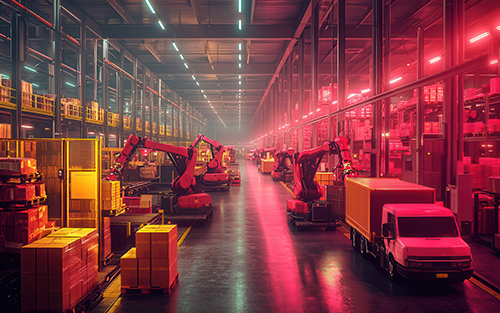summary
Global cargo volume for industrial robots in 2024 was just over 505,000 units in total, reflecting a 2.4% decline compared to 2023.

Global cargo volume for industrial robots in 2024 was slightly above 505,000 units in total, reflecting a 2.4% decline compared to 2023. This decline in cargo, combined with a decline in average prices, led to a decline in sales revenue of -5.8% year-on-year.
A slowdown in investment in the manufacturing sector has been observed in all major regions. In the Asia-Pacific region, a relatively modest decline in robot shipments was -1.1%, while the US and EMEA (Europe, Middle East and Africa) experienced a sharp decline of -3.7% and -8.1%, respectively.
However, although 2024 was closed on a challenging memo, there are signs that the market will be stable. Positive trends in some regional markets for the first quarter of 2025 support the outlook for a progressive recovery.

The recovery in manufacturing shows stability in the industrial robot market
Since late 2024, monthly indicators for both the US and China industrial sectors have shown signs of recovery. Europe has recently begun to show improvements while still moving backwards. The looming tariff uncertainty poses risks to machinery orders in the second half of 2025, but the current trends in demand in major regions suggest that these will not lead to a market-wide contraction.

According to the Japan Robot Association (JARA), manipulator and robot orders rose 32.2% in the first quarter of 2025, and export shipping value increased 22.8%. Japanese robot vendors (according to the Interation Analysis Industrial Robot – 2025 report), which accounted for 47% of global robot revenue in 2024, are often considered reliable indicators of health in the broader market.
In this context, global cargo for industrial robots is projected to increase by 5% in 2025. However, revenue growth is expected to be just 2.6% due to continued downward pressure on average prices.
ARPU drops and pricing
Due to increased production and increased competition, the average revenue per unit of industrial robots (ARPU) has dropped significantly from around $31,100 in 2018 to $25,600 in 2024. In 2024, ARPU fell sharply than in the past few years, falling by -3.6% due to easing inflation and increasing competition.
Fierce price competition has hit manufacturer margins, especially among non-cooperative robotic suppliers whose pricing flexibility has reached its limits. Many emerging brands are actively pursuing market share at the expense of profitability. This led to the expectation that the pace of price erosion would slow down in 2025, with ARPU dropping by a more moderate rate of 1%-2% per year until 2029.
Still, certain product segments may help support pricing. The rise in shipping of large-scale collaborative and Scala robots could help stabilize the ARPU advance.
Co-robots (cobots) have experienced the most sharp declines in ARPUs, mainly due to the increase in low-cost, pure playvenders. In 2023 and 2024, cobot ARPUs were expected to decline by -6.4% and -4.1% respectively, with an additional -3.5% drop in 2025. The influx of these budget-oriented players has shifted competitive landscapes and accelerated price competition within the segment.

Supplier-based fragmentation has exacerbated price competition
The industrial robot market has been integrated over the past few years, with the “Big 4” industrial robot manufacturers (Fanuk, Yakkawa, ABB and Kukaheives) in long-standing dominant positions. However, 2024 showed a shift towards increasing market fragmentation. Among the top 10 vendors, total market share has declined from 64.6% in 2023 to 62.3% in 2024, indicating that they are challenging established manufacturers amid declining demand and increased price pressure.
There are several factors that contributed to this fragmentation.
Many pure plays and new co-robot makers have successfully moved from niche pilots to scalable, general purpose solutions, driving substantial revenue growth. The automotive industry, a traditional hub for major suppliers, has slowed demand for robots, disproportionately affecting the Big Four. In China, offensive price competition prevented major international vendors from participating in low margin bidding, but domestic suppliers were highly competitive.
In summary, 2024 was a year of contraction and strategic reorganization in the industrial robot industry. Slowing freight, lower prices and strengthening competition challenged both revenue and profitability. However, regional signs of recovery, especially in Asia and the US, as well as strong orders from key players like Japanese vendors, show potential for a rebound in 2025.
Final Thoughts
The industrial robot market is making a significant transition. Although 2024 reflected short-term headwinds, structural trends – automatic demand, labor shortages, advances in robotics technology – are firmly in place. The evolution of the continuous supplier-based fragmentation and pricing dynamics redefine the competitive environment, particularly in cost-sensitive segments like co-robots.
Going forward, we will continue to look at the market with caution and optimism. As investment cycles pick up and demand stabilizes in key industries, 2025, while characterized by tougher margins and more subtle competition, could mark the beginning of a new stage of growth. Robot makers need to balance innovation, efficiency and market agility to thrive in this next chapter.
About the author
As a China-based market analyst in interaction analytics, Samanthamu provides support in the Industrial Automation sector. Samantha has her master’s degree in economics and has experience conducting market research in industrial equipment and automotive components while working in Germany.
Have you enjoyed this amazing article?
To read free articles, check out our free e-newsletter.
Subscribe

